By Dave McCracken General Manager
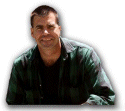
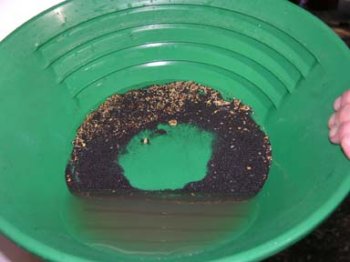
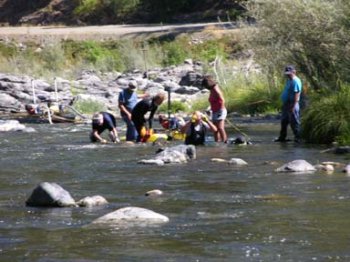
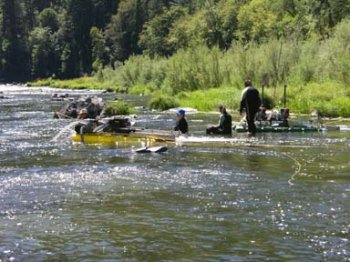
There were 24 of us involved with this particular group dredging project. It was one of the last week-long projects that I personally managed, not because I don”t enjoy getting out on a serious prospecting project. But because projects of this sort require so much focus during the busy part of our season, I am worried about allowing my other management responsibilities to lapse while we are off on some prospecting adventure.
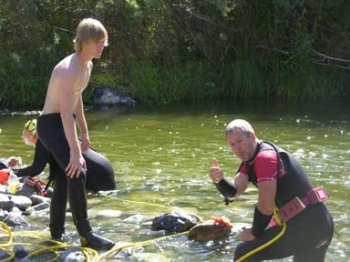 Even though the project took place over a year ago, the story and video segments go a long way to show the camaraderie and great adventures our members share together in The New 49″ers.
Even though the project took place over a year ago, the story and video segments go a long way to show the camaraderie and great adventures our members share together in The New 49″ers.
Of all the week-long dredging projects we organized over the years, this is the one that had the most experienced crew ” ever:
We had longtime miner, Dave Beatson (from New Zealand) working with Craig Colt to manage our 8-inch dredge program up on K-15A in a place where we had already located a pay-streak during an earlier project.
We had longtime, experienced helpers, Matt Johnson and Rick LaRocque, heading up a sampling program on K-14. Another longtime member and experienced dredger, Max Andrewski, was present with his two sons, Paul and Max Junior. Paul and Max Junior both grew up dredging gold on the Klamath River! We were lucky to have them leading a second sampling program onto the lower-end of K-14.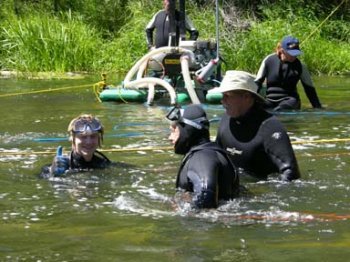
Longtime member and helper, Jeff Bucher, was present to lead a sampling team on the far side of the river at K-15A. During earlier years, Jeff always managed our beginner-crews on these group projects. Jeff is a retired firefighter and has that extra calm and patient way about him that is helpful with beginners who are a bit nervous about getting into the water for the first time.
But Otto Gaither had taken over the beginner-teams during this particular season. Otto had a fairly large crew over on the Hwy-96 side of the river on K-15A. There was a shallow section of river there where Otto had already made a gold discovery; a perfect place for people to experience their first underwater mining adventures. From plenty of practice, Otto was tuned right in on what it would take to get a bunch of beginners off to the right start.
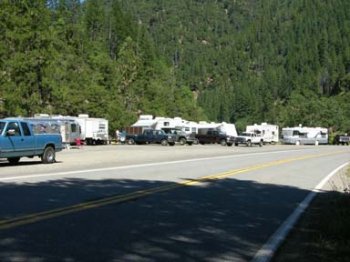 While most of us camped in our popular campground right there at K-15A, this was the first and only time that we ever split one of these projects up so that the prospecting and mining was happening on two separate claims, some 5 miles apart or so. We were able to do this because we had experienced crews on each of the dredges. The two teams we sent up to K-14 could just as easily have gone up there on their own without being involved with our group program.
While most of us camped in our popular campground right there at K-15A, this was the first and only time that we ever split one of these projects up so that the prospecting and mining was happening on two separate claims, some 5 miles apart or so. We were able to do this because we had experienced crews on each of the dredges. The two teams we sent up to K-14 could just as easily have gone up there on their own without being involved with our group program.
There is a lot to be said about directing experienced dredgers in a sampling program. I just had to point out what needed to be done without having to take much time in explaining things.
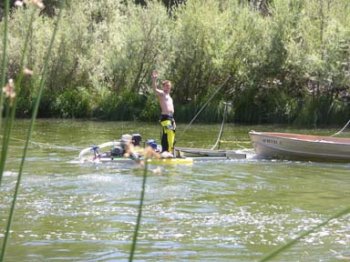
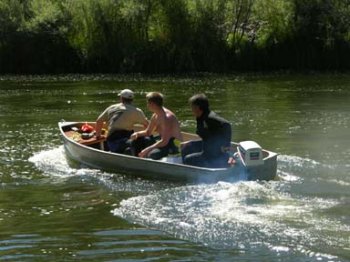
Just a few days before the project, one of our more experienced members located a high-grade pay-streak up on K-14 using a 4-inch dredge, and he invited us to go up there and see if we could locate a piece of his action either up or downstream from where he was already dredging. We have so many gold properties, I have found that it is wise to sample in places where someone has already discovered gold. So I went over and swam under his dredge the day before the project to have a look at what he found. He was recovering some beautiful fine and flake gold out of about 5 feet of nice-looking hard-pack about a third of the way out from the far side of the river. The deposit looked good! It also looked like it might be big. Since we had already identified some gold deposits to mine on K-15A, we decided for starters just to send two of our dredges up to K-14.
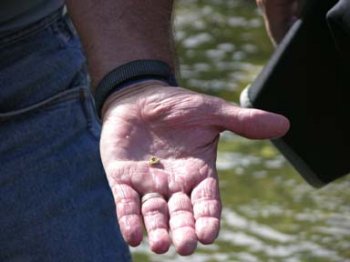
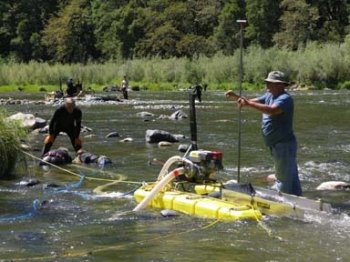
There are quite a lot of logistics involved with putting 24 people effectively to work on six different dredges in multiple locations. On this project, the key was to immediately turn all of the beginners over to Otto. Our photographer, Bella-Linda Williams, is also an experienced suction dredger. She jumped in and devoted the first whole day to helping Otto to teach beginners how to put their faces underwater.
We have known for a long time that it is important to get beginners uncovering some gold as soon as possible. Uncovering treasure along the bottom of the river will immediately extrovert nearly anyone; even people with serious fears about being underwater! Since Otto had located this particular gold deposit in advance, it wasn”t long before Otto”s whole team was absorbed in productive activity.
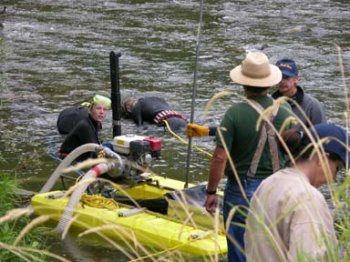
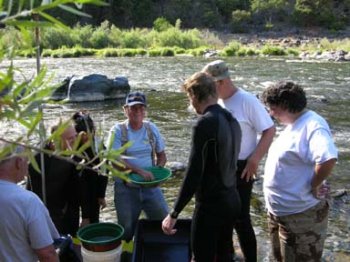
With the beginners in good hands, my main mission during the remainder of the week was to increase gold production as much as possible without compromising safety. In other words, I have to get the participants to mine the gold without anyone getting seriously hurt. This is always the challenge, since the richest gold deposits sometimes seem to be located in the most difficult locations.
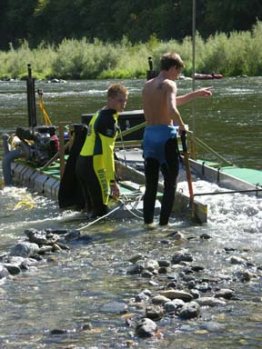
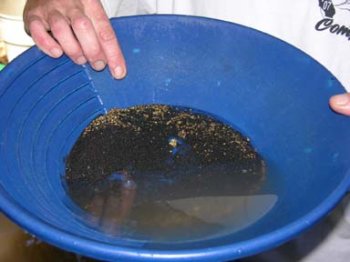
Dave Beatson and Craig Colt had their marching orders even before the week started. They had already dropped back and opened up a dredge hole further behind on the original pay-streak which Eric Bosch and I found at Savage Rapids back in 1983. That year, Eric and I recovered 100 ounces of gold in just two weeks. But we buried the lower-end of the deposit under our tailings and never returned. Our hope on this project was to tap back into the same rich deposit again. Several other helpers jumped in with Dave and Craig on the 8-inch dredge. But the material was deep (9 or 10 feet) to bedrock out there, so they were pretty challenged, and progress was slow. Still, they worked hard all week and made a healthy contribution to the gold recovery. Here is a video segment which captured how the 8-inch program played out during the week:
As it turned out, we had to set up a winch to pull one very large rock out of the way; a monster that had been resting just up in front of the 8-inch production hole. We have learned over the years that it is better to be safe and move anything out of the way that could potentially roll in and hurt someone. In this case, the boulder was very large, and we had to do some fancy block & tackle work to create enough power to move it. Here follows a video segment which shows some of the winch-action:
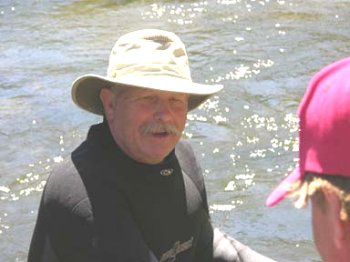
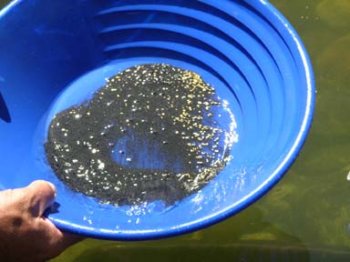
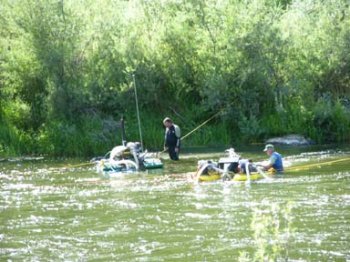
Jeff Bucher took his team to the far side of the river on K-15A, a place where we had been mining a good pay-streak during an earlier project. This involved the use of a motor boat to get people over there and back, along with fuel and other gear. Jeff”s plan was to finish that gold deposit on this project. He gathered up a team of helpers, all who were up to the task. It was a bit challenging over there, because the rocks were big, and the water was pretty fast.
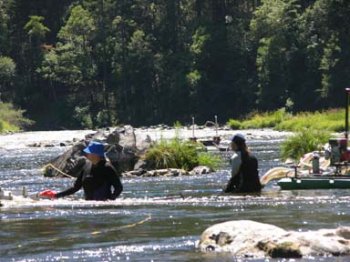
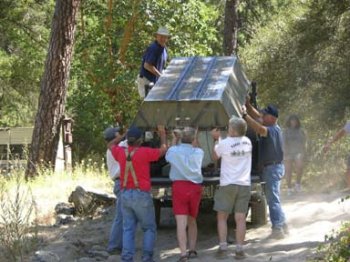
Once we got things organized at K-15A, about a third of us gathered up a 5-inch and 6-inch dredge, and another boat; and we hauled it all up to K-14. With that experienced crew, it didn”t take but just a few hours to get everything set up and running. Since we had plans to sample the middle of the river, we used the boat to help string a rope all the way across the river, keeping it plenty-high so we would not be blocking boat traffic. Nearly everyone there had already done all this before, so we made pretty fast work of it. Both experienced boat operators, I turned that motor boat over to Max and Rick. We had a sampling plan that would have them reaching out into the river from both sides, trying to capture a piece of the high-grade deposit that had already been located just downstream from us.
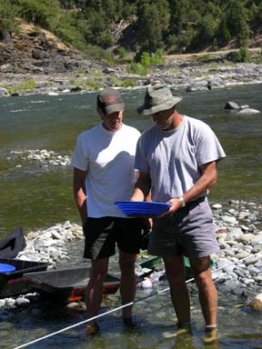
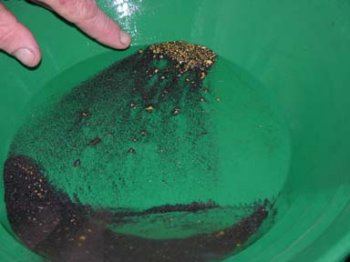
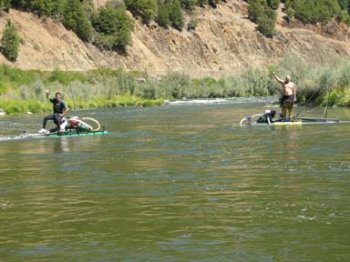
The first thing we did on K-14 was go take a direct look at the pay-dirt where the guy before us was already recovering high-grade gold. From that, we knew exactly what we were looking for as we sampled. Here follows a video segment which captured all of the excitement we were experiencing during our initial moments discovering a brand new gold deposit:
My week was mainly devoted to driving back and forth between K-15A and K-14. The team leaders on each dredge pretty-much managed the activity along the river. Several of the beginners quickly graduated off Otto”s 4-inch dredge and were soon dredging over with Jeff and his team. Shortly thereafter, a few of them were working on the 8-inch dredge with Craig and Dave.
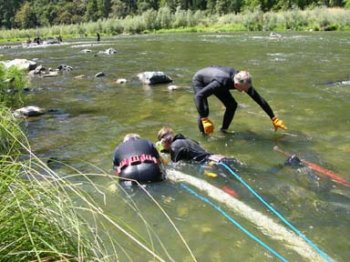
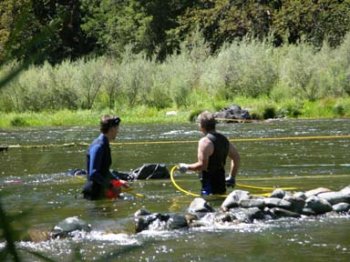
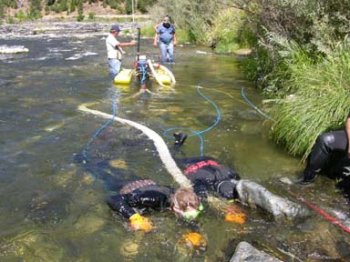 Still, as usual, most of the excitement was taking place on the beginner-dredge. There, it seemed like every few minutes, they were passing up more gold nuggets that they were digging out of the bedrock. I swear, there were times the whole bunch of them were jumping up and down, yelling. Several times, I thought the more serious dredges were going to shut down just to go over and see what all the yelling was about!
Still, as usual, most of the excitement was taking place on the beginner-dredge. There, it seemed like every few minutes, they were passing up more gold nuggets that they were digging out of the bedrock. I swear, there were times the whole bunch of them were jumping up and down, yelling. Several times, I thought the more serious dredges were going to shut down just to go over and see what all the yelling was about!
This is just one reason why we allow Otto to mange the beginner-teams. He has a special way of getting the excitement levels out the roof! I have seen it where everyone was so happy, they just started dancing on the bank, carrying on like it was a New Years eve party! Here is a video segment which captured some of the fun and excitement that Otto”s team was experiencing:
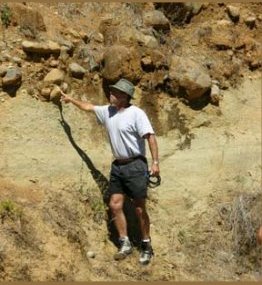 Mainly, for the entire week, the crews at K-15A just worked away at the 3 gold deposits we started in at the beginning of the week. Up on K-14, both of our crews worked their way out to the middle of the river where they joined their dredge holes together. They were dredging in about 18 inches of nice hard-packed streambed on top of bedrock. There, they were picking nuggets out of cracks.
Mainly, for the entire week, the crews at K-15A just worked away at the 3 gold deposits we started in at the beginning of the week. Up on K-14, both of our crews worked their way out to the middle of the river where they joined their dredge holes together. They were dredging in about 18 inches of nice hard-packed streambed on top of bedrock. There, they were picking nuggets out of cracks.
One thing always of great interest to New 49″er members is the high and dry ancient streambed alongside Highway 96 on our K-14 property. Anytime I am there with members, I take the opportunity to point out the exposed streambed material and explain that every time we are sampling either in or out of the water, we are always looking for similar hard-packed streambed. This is material which has been brought in and formed by major flood events. Here follows a video sequence that captured my explanation:
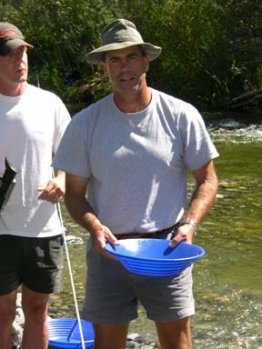
As always on these projects for me, the hours and days went by very fast. We had good team leaders keeping the momentum going and everyone was pitching in. The amount of gold you recover in a mining project is directly proportional to the volume of streambed material which you process from the right places. So once we identify where the pay-dirt is located, our entire focus changes to volume of production. Time goes by really fast when you are in a hurry!
It was particularly interesting for me to have three youthful partners on this team. I am not used to dealing with so much youthful enthusiasm, so I had to make some internal adjustments (the best I could). These younger miners are part of the next generation of leaders that will someday take my place in the industry. That is a pretty sobering thought to me. It is also a relief on some level. It”s nice to know that others are coming along to take over from us “oldtimers” when we start getting tired.
Here follows a video segment put together from different moments during the week:
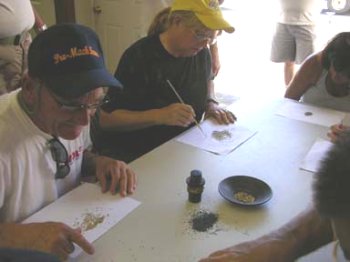
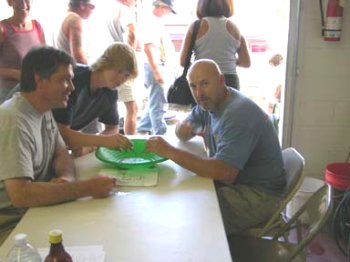
While we do clean-up the high-grade sections of our dredges after every sample, or at the end of every day, we normally do not clean-up our whole dredge recovery systems or do a final clean-up until we get to the end of the week. This is because we don”t want to subtract unnecessary time and energy from the more important work of sampling and production mining. There are only so many work hours in a week, and we always try to use them wisely.
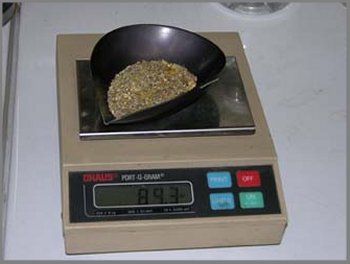
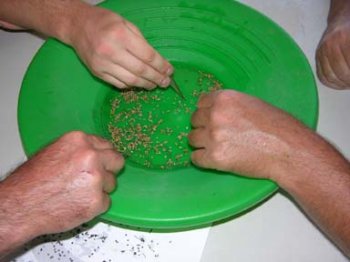
So Friday found all of us working hard to pull some of the dredging gear off the river, and then we returned to Happy Camp and devoted the remaining part of the day to cleaning-up all of the concentrates which we had accumulated during the week. Everybody participates in the final clean-up process, so it is a learning experience for those who have not seen it before. Plus, getting your hands on the gold goes a long way to acknowledge all of the hard work we invested earlier in the week. Ultimately, our gold added up to 88.7 pennyweights (about 4.5 ounces), with 25.9 pennyweights of nuggets. Everybody received an equal share of the gold on Friday afternoon; and with some sadness that we had reached the end of another grand partnership, we all shook hands and went our separate ways. Here follows a video sequence from our clean-up, and from some of our final moments on this project:





